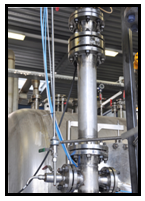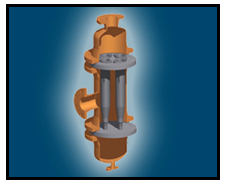Oil&Gas Subsea | Future Trends, Research and Development
BASIC ELEMENTS
To meet rising global demand for oil and gas, the petroleum industry has set out to conquer the deep offshore and in the space of just a few years, this extreme environment has emerged as a key source of new reserves for the future.
The deep offshore is believed to contain more than 5% – an estimated 300 billion barrels – of the world’s liquid hydrocarbon resources, or 12% of total conventional oil resources and in n 2013, deepwater liquid reserves accounted for 6% of global production (source TOTAL). That share is forecast to rise to close to 11% of conventional oil output, or 9 millions barrels per day, by 2035 (source TOTAL).
New discoveries in deepwater are characterised by:
- increasing water depth;
- often remote from existing infrastructure;
- low reservoir pressure requiring artificial lift, sometimes poor quality crude;
- some high pressure, low permeability reservoirs;
- Include installation of subsea processing equipment (demand for more power).
Cost effective development of these new opportunities will require new technology to cope with the above challenges and the table below shows some priorities and key challenges in subsea production technology in different environmental and operational “contexts”.

SUBSEA PRODUCTION SYSTEMS TREND
The overall business Research and Developments is to find and expand solutions for subsea trees, manifolds, jumpers, without increase in costs, and R&D focuses include developing so-called Inspection, Maintenance and Repair (IMR) systems to ensure the long-term reliability of operations and extend the service life of assets.
For the subsea production systems, the following technical challenges are identified:
- Limit the drilling costs, both with respect to the deeper water column and the different well characteristics in deepwater fields
- slim well technology to reduce the well cost and large bore gas well technology to reduce the number of wells.
- Need for equipment, trees, manifolds, jumpers, flowlines and umbilicals that reduce the installation requirement
- Need equipment that provides for minimum environmental impact (zero harmful discharge)
- This is of particular importance for arctic developments
- Need for more precise monitoring of the wells to enhance the recovery, involving communication equipment subsea and downhole
- Need to develop and/or qualify new materials for insulation and buoyancy, compatible with the new deepwater requirements in terms of pressure and temperature.
ULTRA-DEEPWATER INSTALLATION
These development trends strongly challenge the offshore installation industry to continuously improve their ability to perform such activities and to develop new and cost effective installation technologies in order to meet the industry needs.
The following gaps are identified for the installation activities:
- New and cost effective installation methods for deepwater
- Increased installation module weights in deepwater developments will require new alternative installation techniques in order to meet cost-efficiency and safety requirements
- New and innovative installation techniques have to be developed and matured through analysis, model testing and (full) scale verification activities.
- Reliable weather window & vessel response forecasts:
- Reliable weather forecast is crucial for design and analysis of offshore installations, planning of the operations and including selection of suitable installation vessel and equipments as such
- Safe installation operations
- Critical phases during the installation operation are lift off, lift through the wave zone, immersion through the water column and landing at seabed.
- Virtual Reality (VR) support in installation operations
- VR technology is rapidly maturing and visualization techniques combined with integration of different sets of real time data creates a strong and increasingly important tool in planning and execution of high complexity operations including marine installation activities.
- ROV assisted installation is challenging due to reduced visibility due to lack of daylight and ingress of mud particles in the water.
SUBSEA PROCESSING SYSTEMS
It is expected that subsea processing, long-distance tie-back and electric control systems will be the most prominent growth areas in the next years.
Subsea processing (using subsea separation and pumping technologies) was originally conceived as a way to overcome the challenges of extremely deepwater situations, and it has become a viable solution for fields located in harsh conditions where processing equipment on the water’s surface might be at risk.
Subsea processing can achieve the following:
- reduce development cost
- enhance reservoir productivity
- improve subsea system reliability and operability
Subsea processing achieves the above objectives by moving some of the traditional topsides fluid processing to the seabed.
Subsea separation and local re-injection of produced water and/or gas to the reservoir can allow processing equipment to be used more efficiently.
The main types of subsea processing include
- subsea water removal and re-injection or disposal, single-phase and multi-phase boosting of well fluids, sand and solid separation, gas/liquid separation and boosting, and gas treatment and compression.

The Tordis Field Separator – From: Greenland Group
On deepwater or ultra-deepwater fields, subsea boosting is needed to get the hydrocarbons from the seafloor to the facilities on the water’s surface.
Subsea boosting negates backpressure that is applied to the wells, providing the pressure needed from the reservoir to transfer production to the sea surface.
Even in mid-water developments, subsea boosting, or artificial lift, can create additional pressure and further increase recovery from wells, even when more traditional EOR methods are being used.
The technology may be applied to mature brownfield or new greenfield applications.
- Brownfield use usually is indicated by lower reservoir pressure and increased water-cut in later field life.
- Greenfield applications have been installed to overcome low initial reservoir pressure as well as weak reservoir and fluid properties, which often result in poor inflow with uneconomic production rates.
In the early days, most companies thought of subsea processing as a form of artificial lift for subsea field developments – it was considered a brownfield activity, as evident by the early pumping systems being deployed only in late-life fields.
Future field development could benefit from subsea separation technology as it enables a smaller topside processing facility which saves production platform cost.
Additionally, subsea processing in greenfield projects may be the key to an operator’s economics from project start up.
The first step into traditional subsea processing was pumping, soon, the trend moved from pumping alone to include separation and pumping.
Gas and liquids were separated subsea, with the liquids pumped and the gas flowing naturally to surface in order to lower back pressures and maximize efficiency.
These activities – called primary separation – soon evolved into secondary separation in which produced water was cleaned and then injected back into a reservoir.
Continuing the trend gas compression also became a value-added step during subsea processing by compressing the gas on the sea floor to reduce back pressure on the reservoir and prevent slugging.
NEW DEVELOPMENTS IN SUBSEA PROCESSING
There are several solutions for compact separation that are designed specifically according to pipe code, which is of particular interest in ultra-deepwater.
Whether for liquid/liquid, gas/liquid, or solid separation, the equipment can be combined to suit all conditions and separation requirements.
These inline solutions are based on cyclonic technology.
The design includes the following separation components:
- One CDS GasUnie inlet cyclone to remove the gas and dampen slugs.
- Two InLine De Waterer stages for bulk oil-water separation.
- One stage of HydroCyclones for water polishing.
Subsea requires separation efficiency for long-distance transportation of oil.
Some oil fields require an electrostatic coalescer suitable for subsea application.
Electrostatic coalescers physically change the droplet size distribution of the water inside the oil phase.
This IEC can be placed on the inlet, oil outlet nozzles of separators, or at certain locations in pipelines to enhance water/oil separation.
Another trend in subsea processing is sand handling and, once again, an InLine DeSander for multiphase streams containing sand, water, oil, and gas has been proposed and developed to meet this challenge.
Water is separated from the well stream and re-injected into the reservoir.
The system delivers less water to the topside to allow the processing of more oil in the floating unit.
Separating and injecting water subsea improves flow rate to topside facilities, which increases well production, while water injection helps pressurize the reservoir, which also improves oil production.
The inline desander removes most of the sand from the multi-phase well stream which helps avoid sand accumulation and erosion in downstream separation equipment and pumps.
SAFETY AND ENVIRONMENTAL
Ensuring that oil and natural gas production in deep water does not harm marine ecosystems is a top priority and oil companies carry out research to quantify and develop technologies that can reduce the environmental risks of ultra-deepwater oil and gas development.
These efforts include
- research to improve the efficiency of casing cement jobs
- more effectively assess corrosion in subsea equipment
- design improved subsea system monitors
The failure of a subsea production plant could induce fatal hazards and enormous loss to human lives, environments, and properties.
Thus, for securing integrated design safety, core source technologies include subsea system integration that has high safety and reliability and a technique for the subsea flow assurance of subsea production plant and subsea pipeline network fluids.
The evaluation of subsea flow assurance needs to be performed considering the performance of a subsea production plant, reservoir production characteristics, and the flow characteristics of multiphase fluids.
SUBSEA PRODUCTION SYSTEM SIMULATION TECHNOLOGY
There is a growing interest in simulation technology which can analyze the complex technical and heterogeneous systems of subsea production systems.
Dynamic simulation tools allow one to develop, virtually test and analyze components and systems of arbitrary complexity, and with the advent of state of the art software programs these tasks are much easier.
Major benefits of simulation software are:
- Time and cost reduction
- Reduced experiment and measurement effort
- Improved product design and development
- Consideration of rising product variety
- Virtual testing under real conditions
- Unique individual solutions

Area of application of subsea modelling and simulation





